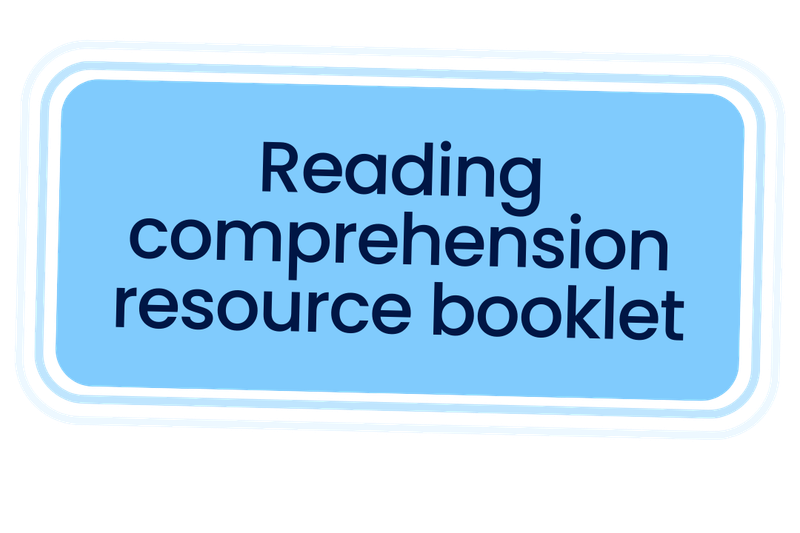What is reading comprehension?
Reading comprehension involves decoding, processing and understanding the words within a text. This is critical to the development of a learner’s literacy skills and vocabulary acquisition. Rather than merely recognising words, learners must be able to assign the correct meaning to them in order to understand the text as a whole, absorb the new information they are being presented with or follow the development and details of a story. Great reading comprehension allows the learner to connect with the text, learn from it and, just as importantly, enjoy the process of reading it.
Why is reading comprehension so important?
Reading comprehension is an essential skill for progressing in all subject areas, not just in English classes – even Maths and Science require a certain level of reading comprehension. Strong reading comprehension also plays a key role in learners becoming more confident communicators as they continue their journey through education and navigate their way through life. Not only will developing robust reading skills significantly increase a learner’s chances of success in academic, professional and social settings, but it can also instil in learners the joy of reading for pleasure. The importance of reading for pleasure should not be underestimated because it has many personal benefits as well as academic advantages such as introducing learners to new cultures and concepts, increasing self-confidence and improving mental wellbeing.
It is important to establish and maintain positive practices as soon as possible, both at home and in the classroom when it comes to the successful formation and development of a learner’s literacy skills. An Ofsted report examining trends in reading for purpose and pleasure highlights that “the early introduction of a broad range of reading strategies [is] inextricably linked to the aim of engaging pupils in reading with understanding.”
What are the benefits of a varied approach to reading comprehension activities?
Undertaking regular, varied and engaging reading activities at home and at school is essential for the advancement of a learner’s reading comprehension skills, and in maintaining their motivation to continually develop their literacy skills as they get older. Making reading a fun, interactive and purposeful experience from an early age will increase the learner’s enjoyment and give them the confidence to tackle increasingly diverse and complex texts, not to mention providing them with the linguistic tools they need to thrive in their academic and personal lives.
Mixing it up, keeping it fresh, basing reading exercises on subjects that the learner will be interested in and presenting activities in appealing formats are key to achieving successful results. By introducing a variety of texts, resources, visual aids, creative exercises and interactive activities, educators and parents can support learners to develop their reading comprehension in meaningful and pleasurable ways that make learning an enjoyable and interactive experience.
15 reading comprehension activities
1. Complete the Sentence
Ask learners to choose the correct word from a list of options to complete the sentences. For more advanced sentence completion activities, they may be asked to select between two options for the same blank space or to insert the most appropriate word of their own choosing without the aid of prompts.
These sentence completion activities promote logical thinking and help to consolidate vocabulary acquisition in particular subject areas. Making the theme of the sentences fun, interesting and relevant can also be effective in inspiring learners to start expressing their own ideas and opinions about different topics.
2. Word Hunt
Encourage learners to turn detective by asking them to hunt for individual words within a piece of text. Say each word aloud one at a time and ask the learners to mark it off or draw a circle around it. To make it as fun as possible, learners can be put into teams with a prize for the team who hunts down the most words.
This activity sharpens listening skills, helps to develop word recognition abilities and teaches learners how to pronounce new words.
3. Word Search
A more challenging take on the word hunt activity, word searches involve learners having to find a list of words that have been concealed in a grid. Keep it interesting by choosing an appealing theme and applying a colour code to the word search, requiring learners to mark off each word they find in the grid in the same colour as it is written on the list.
Word searches enhance analytical skills in younger learners, as well as improving their spelling, increasing their vocabulary and developing their ability to identify linguistic patterns This activity is also an effective method of consolidating learning if a topic with new vocabulary has recently been introduced to the learner.
4. Search for the Synonym
Adding another level of difficulty and interest to the word hunt and word search activities, tasking learners to find synonyms requires them to identify different words that convey the same meaning as the original list of words provided.
Synonym activities are more suitable for older learners, and they are an effective method of increasing vocabulary and breadth of expression, in addition to giving learners the confidence to tackle increasingly complex texts and the ability to produce more varied prose in their own writing exercises.
5. Reading Aloud
Reading aloud is a simple yet effective way of boosting reading comprehension and it can be done in the classroom, at home, at a local library or anywhere else that offers a quiet space and access to level-appropriate texts.
Reading aloud brings the text to life by injecting intonation and expression into it, as well as giving the learners the chance to hear how new words are pronounced and practise the pronunciation themselves if they are the ones doing the reading. Reading aloud also helps to hone listening skills and will particularly benefit those who learn best through listening.
6. Guided Reading
Guided reading is a teacher-led activity which teams up small groups of learners who are at the same reading level and who may be facing similar challenges in the development of their reading comprehension skills. The small group model enables the teacher to differentiate their approach depending on the individual learning needs of each participant. Each group is given a level-appropriate text to read with clear and regular guidance provided throughout the activity by the teacher to aid the learners in developing their own strategies for understanding meaning and dealing with any new vocabulary along the way. After the text has been read, the teacher will usually consolidate learning by asking the participants to complete a writing activity based on the text or to contribute to a question-and-answer session.
According to Pearson, if undertaken successfully, guided reading helps learners to develop a range of strategies to improve reading comprehension, including predicting, clarifying, questioning, summarising, visualising and evaluating. Perhaps most importantly, Pearson’s study reveals that effective guided reading sessions can increase the learner’s desire to read for pleasure outside of the classroom.
7. True or False?
True or false activities can take the form of a quiz after reading a text, which can be done either verbally or as a written exercise. Learners must identify the correct information within the text to determine whether each given statement is true or false, requiring them to reread the text carefully and iron out any nuances along the way.
True or false tasks can promote active reading as learners must delve deeply into the text in order to understand its meaning and correctly assess the information provided. Choosing a specific topic that is interesting to the learner, such as science, the environment, or a historical figure, for example, can also inspire them to do further reading on the subject to learn more about it.
8. Retelling a Story
In order to be able to accurately convey written information to another person, the learner needs to fully understand it themselves. Choosing an engaging story which the learners will relate to encourages them to be more focused and attentive. The key themes and background of the story can be established prior to reading it. Learners can either be asked to read it themselves or it can be read to them whilst they listen. After giving the learner a sufficient amount of time to review and reflect on the story, ask them to retell it in their own words, following the correct sequence of events and including as much detail as possible.
In addition to enhancing speaking and listening skills and the ability to memorise key information, asking a learner to retell a story is an excellent method of checking their understanding of a text and an effective way of helping them to expand their own vocabulary as they attempt to paraphrase the original text and practise using synonyms.
9. Describe the Characters
Ask the learner to identify the different characters in a story and find information about them from the text and any pictures within the story. Set a target of finding four or five features of the characters, such as physical appearance, what they are wearing, how they are feeling, what they are doing, where they are, or their relation to other characters in the story. This can be done verbally or by instructing the learners to make a list or draw a chart to organise the information.
This activity builds upon the learner’s ability to extract specific information from a text by using linguistic and visual clues to find out what they need to know. It also provides the opportunity to acquire new vocabulary and practise using different descriptors.
10. Role Playing
Role-playing is a very useful and entertaining tool in the advancement of reading comprehension because it promotes active participation. Scenarios can be based on characters from a story, a non-fiction text or an imagined real-life situation, for which learners are assigned parts and given a simple script to follow that is appropriate for their reading level. For more advanced role-play activities, learners can be given cue cards or supported to write their own dialogue with the aid of keywords and visual stimuli.
As well as being fun, preparing for and acting out the role play will help to deepen the learner’s understanding of the source text and encourage them to engage more actively with the written material. Role-playing also promotes empathy for others as it requires the learners to put themselves in the position of another character or person. It has the added advantages of developing team-building skills and collaboration with others if they are working in a group.
11. What Happens Next?
An enjoyable and stimulating progression exercise following on from a role play activity based on a story is asking learners to imagine what happens next. Having already put themselves in someone else’s shoes, their creative thinking and exploration of the language used in the source text can be taken a step further by inviting them to continue the story.
This activity requires close consideration of the words used to describe the theme, characters, setting and any other clues in the text that will give the learner the information they need to help them imagine a logical continuation of the story. This acts to draw the learner into the text and transforms them from being a passive reader into an active participant who seeks to examine and expand on the vocabulary in the text.
12. What’s Missing From the Picture?
Whether it is a picture of a popular sportsperson or actor, a character from a story or a photo of a famous place, choose an image that will appeal to the learners and provide a description of it. The description should also contain one or two extra details that aren’t in the image and working individually or in a team, the learners must identify the anomalies.
Using a visual aid to compare and contrast the image with the information in the text encourages learners to ask questions to clarify meaning and develops their analytical skills.
13. Graphic Organisers
Graphic organisers are visual aids which help the learner break down the information in the text and arrange it in a logical sequence. Rather than tackling the entire text head-on, the learner can separate it into more manageable chunks and take it one step at a time whilst also being able to see the relationship between each key point of the text. The format of the graphic organiser can range from a simple T-chart to a more complex flow chart or a Venn diagram, depending on the age and ability of the learner. To further encourage their active participation in the exercise, learners can be asked to make their own graphic organiser.
Using a graphic organiser to create a visual breakdown of the text can help learners to consolidate their understanding of what they are reading because they are actively involved in analysing, categorising and summarising the information they are presented with and converting it into a more accessible format for themselves.
14. Make a mind map
Similar to a graphic organiser, a mind map is a visual aid to help learners identify, process and understand the information in a story or a piece of non-fiction writing. The subject (which could be the title of the story or topic) is placed in the middle of the page, with boxes, circles or other shapes flowing outwards from the main title, and arrows or lines linking them together in a logical yet organic way.
Again, learners can be asked to create their own mind maps and enjoy adding different colours and drawings, customising it as they wish to help them break down the text and feel fully engaged in the activity. In addition to the main points of the text, any new vocabulary can be added to the mind map, too.
A mind map can help learners to structure their thoughts and convert what they may view as complex text into a more user-friendly layout. By creating their own colourful visual aid, learners can get to the very root of the main ideas in the text as well as proactively note down any new vocabulary in a format that makes it easier for them to digest. Learning how to create mind maps can also be incredibly beneficial for older learners in helping them to retain information when revising for exams and taking notes in class.
15. Make a comic strip
Whether it is a story about their favourite superhero or cartoon character, comics are an ideal tool for making reading more fun and accessible to learners because of their colourful, visually appealing layout, distinctive captions and speech bubbles, and use of images to help the story progress. Learners who may struggle with a continuous block of text will be able to follow the story in a comic more easily thanks to the linear, frame-by-frame narrative style and abundance of visual stimuli.
After reading the original comic strip together, get the learners to imagine how the adventure continues by creating their own mini-comic. A template can be provided, or they can design their own to make them feel even more involved in the task.
Asking learners to create their own comic will encourage them to re-examine the layout and language used in the original comic strip and to discuss the meaning of any new words they come across along the way. It is also great for fuelling creative thinking and the ability to organise written information in a structured sequence.
How Bedrock Learning improves reading comprehension
Our digital learning platform provides immersive, stimulating and inclusive reading comprehension activities for all school-age learners, with courses available for use at school and at home, along with clear and encouraging benchmarks to map individual progress and achievements. Designed by teachers who understand how much reading comprehension impacts academic outcomes and affects personal development, our lessons are centred on equipping learners with the literacy skills needed to succeed in school and in life.
Bedrock offers an extensive curriculum of lessons and resources aimed at cultivating reading comprehension skills in learners in a natural, enjoyable way that they can relate to and appreciate. This includes the use of original fiction texts, which combine human-narrated stories, adventurous plots, interesting characters and reading level-appropriate vocabulary embedded into each story. Providing an immersive experience for learners through the use of original fiction enhances vocabulary acquisition and retention, introduces learners to diverse cultures and settings, and stimulates their enjoyment of reading, as well as increasing concentration and encouraging healthy long-term reading habits.
Our digital vocabulary curriculum features a range of innovative strategies for establishing and honing key reading comprehension skills in learners throughout their journey through school, along with flexible and fun methods of improving reading comprehension outside of the classroom and tips for establishing a regular and rewarding reading routine at home.
Summary
Don’t be afraid to think outside the box when planning and delivering reading comprehension activities for learners. The more varied and interactive the resources and activities are, the more the learners will develop their skills and enjoy learning. Improving reading comprehension skills and establishing an enduring love of reading doesn’t have to begin or end in the classroom. Instilling positive reading habits in young learners will pay dividends throughout the rest of their lives.
Please do have a go at some or all of the reading comprehension activities featured in this blog with your learners, and for further information about our digital literacy curriculum or our approach to literacy education, feel free to get in touch with us here at Bedrock Learning.






